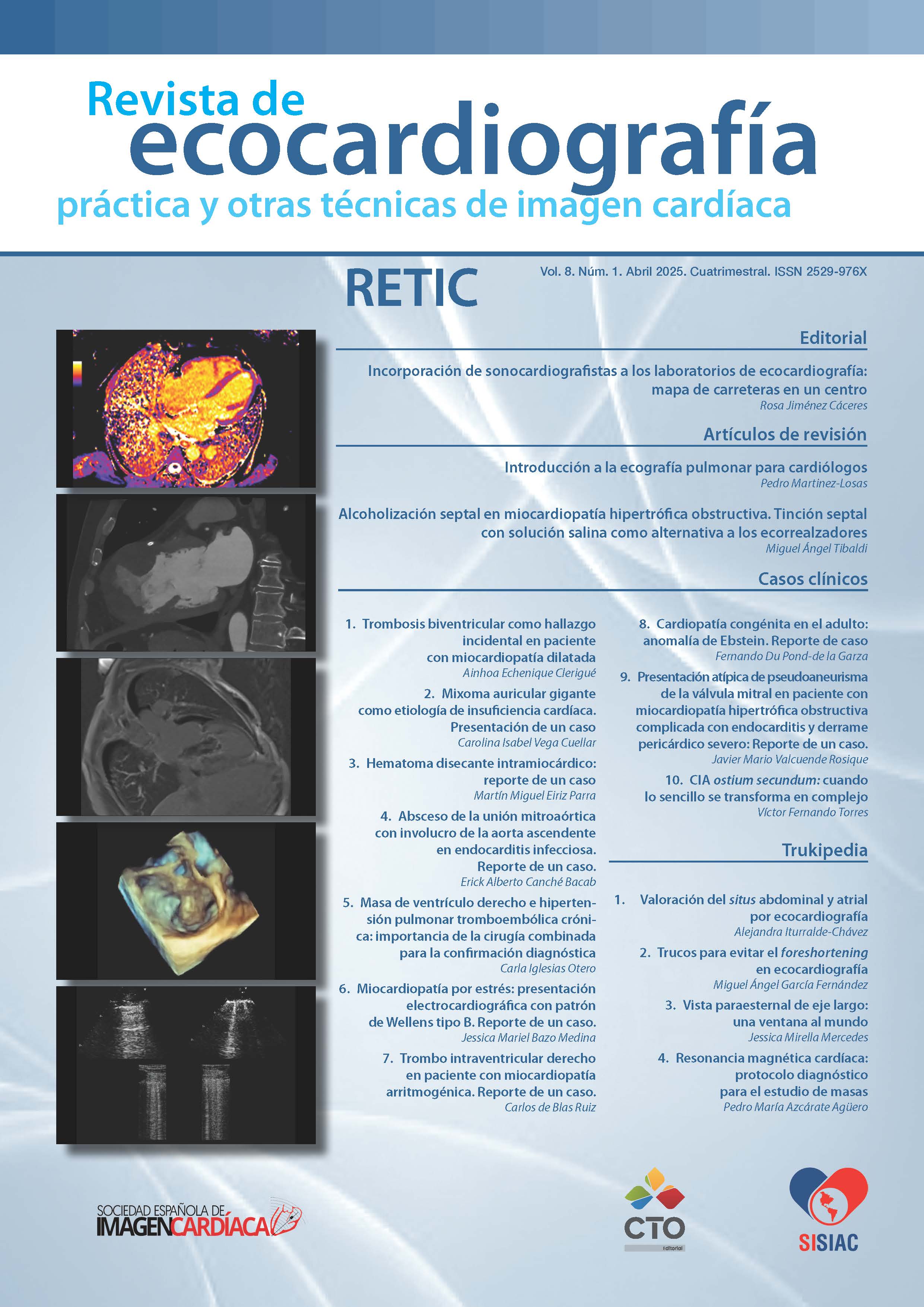Alcoholización septal en miocardiopatía hipertrófica obstructiva. Tinción septal con solución salina como alternativa a los ecorrealzadores
DOI:
https://doi.org/10.37615/retic.v8n1a3Palabras clave:
obstrucción del tracto de salida, ecocardiografía transesofágica, insuficiencia cardíacaResumen
La miocardiopatía hipertrófica (MCH) es una enfermedad causada por mutaciones monogénicas sarcoméricas y caracterizada por hipertrofia ventricular izquierda inexplicable. Cuando el tratamiento médico es inefectivo, una alternativa terapéutica es la reducción del espesor septal, siendo la miomectomía septal quirúrgica de elección cuando se realiza en centros de alto volumen y experiencia. No obstante, otra opción menos invasiva es la alcoholización septal.
Presentamos dos pacientes —con reiterados ingresos por insuficiencia cardíaca—, a quienes se realizó alcoholización septal como alternativa a la miomectomía quirúrgica. El objetivo es destacar y explicar la selección apropiada de las ramas septales, utilizando la inyección de solución fisiológica agitada, sin necesidad de ecorrealzadores de alto costo y difícil acceso.
Descargas
Métricas
Citas
Ommen SR, Mital S, Burke MA, et al. 2020 AHA/ACC guideline for the diagnosis and treatment of patients with hypertrophic cardiomyopathy: executive summary: a report of the American College of Cardiology/ American heart association Joint committee on clinical Practice guidelines. Circulation. 2020;142(25):e558-e631. doi: https://doi.org/10.1161/CIR.0000000000000938 DOI: https://doi.org/10.1161/CIR.0000000000000945
Pérez-Sánchez I, Romero-Puche A, García-Molina Sáez E, et al. Factors Influencing the Phenotypic Expression of Hypertrophic Cardiomyopathy in Genetic Carriers. Rev Esp Cardiol (Engl Ed). 2018;71(3):146-154. doi: https://doi.org/10.1016/j.rec.2017.06.002 DOI: https://doi.org/10.1016/j.rec.2017.06.002
Pasipoularides A. Genomic translational research: Paving the way to individualized cardiac functional analyses and personalized cardiology. Int J Cardiol. 2017;230:384-401. doi: https://doi.org/10.1016/J.ijcard.2016.12.097 DOI: https://doi.org/10.1016/j.ijcard.2016.12.097
Gersh BJ, Maron BJ, Bonow RO, et al. 2011 ACCF/AHA Guideline for the Diagnosis and Treatment of Hypertrophic Cardiomyopathy: a report of the American College of Cardiology Foundation/American Heart Association Task Force on Practice Guidelines. Developed in collaboration with the American Association for Thoracic Surgery, American Society of Echocardiography, American Society of Nuclear Cardiology, Heart Failure Society of America, Heart Rhythm Society, Society for Cardiovascular Angiography and Interventions, and Society of Thoracic Surgeons. J Am Coll Cardiol. 2011;58(25):e212-60. doi: https://doi.org/10.1016/j.jacc.2011.06.011 DOI: https://doi.org/10.1016/j.jacc.2011.06.011
Harmon KG, Drezner JA, Wilson MG, Sharma S. Incidence of sudden cardiac death in athletes: a state-of-the-art review. Heart. 2014;100(16):1227-34. doi: https://doi.org/10.1136/heartjnl-2014-093872.rep DOI: https://doi.org/10.1136/heartjnl-2014-093872.rep
Hegde SM, Lester SJ, Solomon SD, et al. Effect of Mavacamten on echocardiographic features in symptomatic patients with obstructive hypertrophic cardiomyopathy. J Am Coll Cardiol. 2021;78(25):2518-2532. doi: https://doi.org/10.1016/j.jacc.2021.09.1381 DOI: https://doi.org/10.1016/j.jacc.2021.09.1381
Olivotto I, Oreziak A, Barriales-Villa R, et al. Mavacamten for treatment of symptomatic obstructive hypertrophic cardiomyopathy (EXPLORER-HCM): a randomised, double-blind, placebo-controlled, phase 3 trial. Lancet. 2020;396(10253):759-769. doi: 10.1016/S0140-6736(20)31792-X DOI: https://doi.org/10.1016/S0140-6736(20)31792-X
Elliott PM, Gimeno JR, Tomé MT, et al. Left ventricular outflow tract obstruction and sudden death risk in patients with hypertrophic cardiomyopathy. Eur Heart J. 2006;27(16):1933-41. doi: https://doi.org/10.1093/eurheartj/ehl041 DOI: https://doi.org/10.1093/eurheartj/ehl041
Ho CY, Mealiffe ME, Bach RG, et al. Evaluation of Mavacamten in Symptomatic Patients With Nonobstructive Hypertrophic Cardiomyopathy. J Am Coll Cardiol. 2020;75(21):2649-2660. doi: https://doi.org/10.1016/j.jacc.2020.03.064 DOI: https://doi.org/10.1016/j.jacc.2020.03.064
Maron BJ, Desai MY, Nishimura RA, et al. Management of Hypertrophic Cardiomyopathy: JACC State-of-the-Art Review. J Am Coll Cardiol. 2022;79(4):390-414. doi: https://doi.org/10.1016/j.jacc.2021.11.021 DOI: https://doi.org/10.1016/j.jacc.2021.11.021
Hassenstein P, Storch HH, Schmitz W. Results of electrical pacing in patients with hypertrophic obstruction cardiomyopathy. Thoraxchir Vask Chir. 1975;23(5):496-8. doi:https://doi.org/10.1055/s-0028-1097017 DOI: https://doi.org/10.1055/s-0028-1097017
Woo A, Williams WG, Choi R, et al. Clinical and echocardiographic determinants of long-term survival after surgical myectomy in obstructive hypertrophic cardiomyopathy. Circulation. 2005;111(16):2033-41. doi: https://doi.org/10.1161/01.CIR.0000162460.36735.71 DOI: https://doi.org/10.1161/01.CIR.0000162460.36735.71
Ferrazzi P, Spirito P, Iacovoni A, et al. Transaortic chordal cutting: mitral valve repair for obstructive hypertrophic cardiomyopathy with mild septal hypertrophy. J Am Coll Cardiol. 2015;66(15):1687-96. doi: https://doi.org/10.1016/j.jacc.2015.07.069 DOI: https://doi.org/10.1016/j.jacc.2015.07.069
Sorajja P, Valeti U, Nishimura RA, et al. Outcome of alcohol septal ablation for obstructive hypertrophic cardiomyopathy. Circulation. 2008;118(2):131-9. doi: https://doi.org/10.1161/CIRCULATIONAHA.107.738740 DOI: https://doi.org/10.1161/CIRCULATIONAHA.107.738740
Liebregts M, Faber L, Jensen MK, et al. Outcomes of Alcohol Septal Ablation in Younger Patients With Obstructive Hypertrophic Cardiomyopathy. JACC Cardiovasc Interv. 2017;10(11):1134-1143. doi: https://doi.org/10.1016/j.jcin.2017.03.030 DOI: https://doi.org/10.1016/j.jcin.2017.03.030
Publicado
Cómo citar
Número
Sección
Licencia
Derechos de autor 2025 Miguel Ángel Tibaldi, Mayra Florencia Valdez, Natalia Romero, Judith Mailén Vicentin, Hugo Londero, Guillermo Pacheco

Esta obra está bajo una licencia internacional Creative Commons Atribución-NoComercial-SinDerivadas 4.0.
RETIC se distribuye bajo la licencia Creative Commons Reconocimiento-NoComercial-SinDerivadas 4.0 Internacional (CC BY-NC-ND 4.0) https://creativecommons.org/licenses/by-nc-nd/4.0 que permite compartir, copiar y redistribuir el material en cualquier medio o formato, bajo los siguientes términos:
- Reconocimiento: debe otorgar el crédito correspondiente, proporcionar un enlace a la licencia e indicar si se realizaron cambios. Puede hacerlo de cualquier manera razonable, pero no de ninguna manera que sugiera que el licenciante lo respalda a usted o su uso.
- No comercial: no puede utilizar el material con fines comerciales.
- No Derivados: si remezcla, transforma o construye sobre el material, no puede distribuir el material modificado.
- Sin restricciones adicionales: no puede aplicar términos legales o medidas tecnológicas que restrinjan legalmente a otros de hacer cualquier cosa que permita la licencia.









